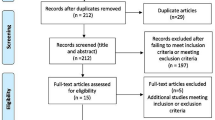Abstract
Background
The FloShield Air System® is a new device for laparoscopic surgery that utilizes a continuous dry CO2 gas flow over the scope to defog the lens and protect it from condensation, debris and smoke. We set out to compare the performance and efficiency of the device in terms of operative lens vision quality (OLVQ) with the reference technique (water + povidone-iodine (PVI) solution) during gynecologic laparoscopic surgery.
Materials and methods
We conducted a single-center randomized prospective study between March and June 2016 (Trials Database Registration NCT02702531) including 53 patients undergoing gynecologic laparoscopic surgery with water + PVI solution and 51 patients who underwent surgical procedures with the FloShield Air System.
The primary outcome measure was the number of laparoscope removals during surgery. Secondary outcome measures were the time to clean, assessment of the quality of vision, the correlation between the laparoscopic surgical complexity and outcomes, and cost effectiveness.
Results
Overall, the mean patient age was 43.2 years (range 22–86) and body mass index 24.8 (range 16.8–42.7). The mean number of endoscope removals during surgery was 7.0 (range 0–37) in the water + PVI solution arm and 2.8 (range 0–12) in the FloShield Air System® arm. The number of removals was significantly lower in the FloShield arm (p < 0.001). No difference in time to clean, quality of vision, level of laparoscopic procedure complexity, or cost was observed between the groups.
Conslusions
The FloShield Air System® resulted in fewer laparoscopic lens removals than the water + PVI solution solution, but that there was no difference in quality of vision, cleaning time or cost, especially for the more complex surgery.

Similar content being viewed by others
References
Chung RS, Rowland DY, Li P, Diaz J (1999) A meta-analysis of randomized controlled trials of laparoscopic versus conventional appendectomy. Am J Surg 177(3):250–256
Karthikesalingam A, Markar SR, Holt PJE, Praseedom RK (2010) Meta-analysis of randomized controlled trials comparing laparoscopic with open mesh repair of recurrent inguinal hernia. Br J Surg 97(1):4–11
Canis M, Mage G, Wattiez A et al (1994) The role of laparoscopic surgery in gynecologic oncology. Curr Opin Obstet Gynecol 6(3):210–214
Kehoe SM, Ramirez PT, Abu-Rustum NR (2007) Innovative laparoscopic surgery in gynecologic oncology. Curr Oncol Rep 9(6):472–477
Chen S-H, Li Z-A, Du X-P (2016) Robot-assisted versus conventional laparoscopic surgery in the treatment of advanced stage endometriosis: a meta-analysis. Clin Exp Obstet Gynecol 43(3):422–426
Donnez J, Dolmans M-M (2016) Uterine fibroid management: from the present to the future. Hum Reprod Update. doi:10.1093/humupd/dmw023
Moawad NS, Santamaria E, Rhoton-Vlasak A, Lightsey JL (2016) Laparoscopic ovarian transposition before pelvic cancer treatment: ovarian function and fertility preservation. J Minim Invasive Gynecol. doi:10.1016/j.jmig.2016.08.831
Lawrentschuk N, Fleshner NE, Bolton DM (2010) Laparoscopic lens fogging: a review of etiology and methods to maintain a clear visual field. J Endourol Endourol Soc 24(6):905–913
Sunny S, Cheng G, Daniel D et al (2016) Transparent antifouling material for improved operative field visibility in endoscopy. Proc Natl Acad Sci USA. doi:10.1073/pnas.1605272113
Yong N, Grange P, Eldred-Evans D (2016) Impact of laparoscopic lens contamination in operating theaters: a study on the frequency and duration of lens contamination and commonly utilized techniques to maintain clear vision. Surg Laparosc Endosc Percutan Tech 26(4):286–289
Mowbray N, Ansell J, Warren N et al (2013) Is surgical smoke harmful to theater staff? A systematic review. Surg Endosc 27(9):3100–3107
Mohammadhosseini B (2010) Povidone-iodine surgical scrub solution prevents fogging of the scope’s lens during laparoscopic surgery. Surg Endosc 24(6):1498–1499; author reply 1500
Balayssac D, Pereira B, Bazin J-E et al (2016) Warmed and humidified carbon dioxide for abdominal laparoscopic surgery: meta-analysis of the current literature. Surg Endosc. doi:10.1007/s00464-016-4866-1
Binda MM (2015) Humidification during laparoscopic surgery: overview of the clinical benefits of using humidified gas during laparoscopic surgery. Arch Gynecol Obstet 292(5):955–971
Van Deurzen DFP, Mannaerts GHH, Jakimowicz JJ, Cuschieri A (2005) Prevention of lens condensation in laparoscopic surgery by lens heating with a thermos flask. Surg Endosc 19(2):299–300
Piromchai P, Kasemsiri P, Thanaviratananich S (2011) Alternative agents to prevent fogging in head and neck endoscopy. Clin Med Insights Ear Nose Throat 4:1–4
ITU-T (2000) Subjective video quality assessment methods for multimedia applications. Available at: http://www.videoclarity.com/PDF/T-REC-P.910-199909-I!!PDF-E[1].pdf. Accessed 13 Mar 2013
Iyer R, Gentry-Maharaj A, Nordin A et al (2015) Predictors of complications in gynaecological oncological surgery: a prospective multicentre study (UKGOSOC-UK gynaecological oncology surgical outcomes and complications). Br J Cancer 112(3):475–484
Dexter F, Traub RD (2002) How to schedule elective surgical cases into specific operating rooms to maximize the efficiency of use of operating room time. Anesth Analg 94(4):933–942, table of contents
http://www.atih.sante.fr/information-sur-les-couts/enc-presentation
World Health Organization (2002) Female sterilization: a guide to provision of services. WHO, Geneva
Kitano S, Tomikawa M, Iso Y et al (1992) A safe and simple method to maintain a clear field of vision during laparoscopic cholecystectomy. Surg Endosc 6(4):197–198
Author information
Authors and Affiliations
Corresponding author
Ethics declarations
Disclosures
Drs Bendifallah, Salakos, Naoura, Aristizabal, Furet, Zilberman and Prs Ballester, and Darai have no conflicts of interest or financial ties to disclose.
Electronic supplementary material
Below is the link to the electronic supplementary material.
Rights and permissions
About this article
Cite this article
Bendifallah, S., Salakos, E., Naoura, I. et al. Prospective, randomized comparison of the use of FloShield Air System® versus the reference technique (water + povidone-iodine solution) during gynecologic endoscopic surgery to evaluate the operative lens vision quality. Surg Endosc 32, 1593–1599 (2018). https://doi.org/10.1007/s00464-017-5642-6
Received:
Accepted:
Published:
Issue Date:
DOI: https://doi.org/10.1007/s00464-017-5642-6




